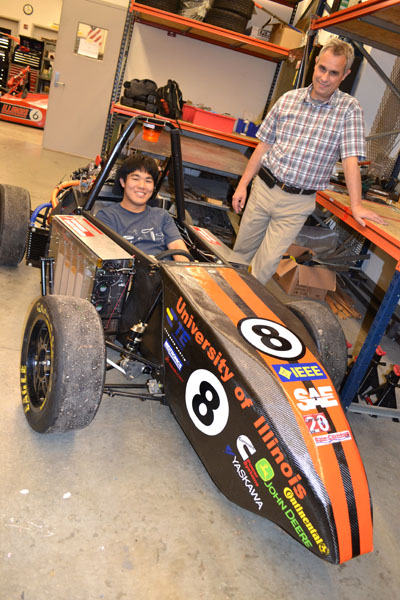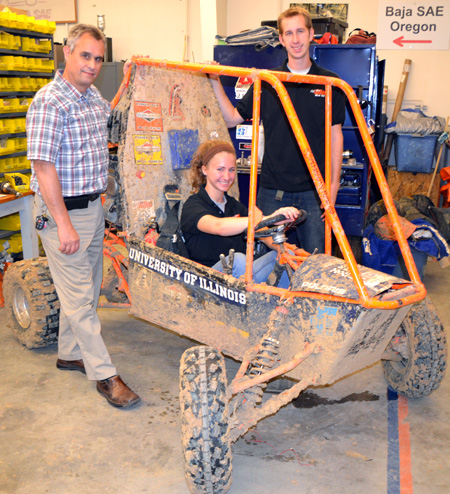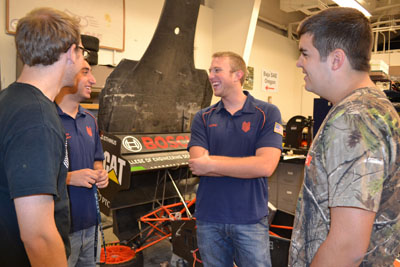Hands-On Experience With Cars Prepares Students to Problem Solve Down the Road

Hybrid team student Mark Teramoto and Mike Philpott with the 2012 Hybrid SAE car.
October 10, 2012
For the last five years at least, Illinois' Mike Philpott has been working double shifts. Most days, the Interim Associate Head for Undergraduate Programs may be found in the Department of Mechanical Science and Engineering, or teaching ENG 491. Evenings, weekends, and probably part of Christmas break, however, Philpott, who is passionate about teaching engineering design via practical design/build/compete projects, can be found supervising students at the Engineering Students Project Lab. Or watching students navigate cars around cones on Assembly Hall's parking lot. Or keeping his fingers crossed in downtown Houston in hopes that his team will travel six miles on a miniscule amount of gas. Or holding his breath lest the Formula SAE car break down during the main competition in Michigan.
As the instructor for ENG 491/ME199 SAE and faculty advisor for ME 470 Senior Design, Philpott serves as faculty advisor to Illinois' five multidisciplinary race car teams. The three Illini Motor Sports teams—Formula SAE (the most developed program, with about 80 students); Baja (off road); and Hybrid (electric and gasoline)—race as part of SAE International (formerly Society of Automotive Engineers). The Shell EcoMarathon Prototype and Urban Concept teams strive for fuel efficiency.
Students on these teams register for one of the courses, plus participate in extracurricular, student-run organizations. For example, Formula SAE team students register for ENG 491: SAE section (for seniors) or ME 199 SAE (for underclassmen) and also participate in Illini Motor Sports. EcoMarathon team members take ME 470 senior design and are part of Eco Illini or Illini EcoConcept.
Unique, multidisciplinary engineering courses, ENG 491/ME 199 don't just involve designing and building a car. After receiving instruction on relevant topics, students from engineering (mechanical, electrical, aerospace, agriculture, computer, etc.) but also non-engineering disciplines, such as business, divide into sub-teams: engine, chassis, body, electronics, business, etc. In fact, business students are integral to the teams. Not only is a business presentation part of the competition, but teams require a lot of sponsors.

Simon Du, Mike Philpott, and Mark Teramoto examine the 2012 Hybrid's circuitry.
"One of the challenges," explains Philpott, "is to design and build a car in budget. You only have a certain amount of money. One of the jobs of business sub-teams…is to get sponsors and to get money out of them, as well as in-kind contributions, for example, give us tires." Plus, teams need to purchase parts from companies who make them according to student-designed specifications.
Another unique aspect of ENG 491: while most courses are taken only once, students take ENG 491each year. Structured to evolve, the course addresses different topics each year, including presentations by guest speakers from sponsors whose logos are emblazoned on the cars, such as Bosch, Caterpillar, Ford, Lockheed, SpaceX, etc.
Besides being multi-disciplinary, teams are comprised of students of all ages and structured so younger students learn from the older. Joining as freshmen, students work their way up to become sub-team leaders or team leaders. Seniors, who know the ropes, typically run the training and the competition. This continuity allows teams to evolve their previous year's design, rather than starting from scratch each year.
Fall and early spring, teams design and build the car, and compete from April–June. The programs all have different races in different places, with students competing both nationally and internationally.

Senior Zachary Weiner in the 2012 Formula SAE car. In last spring's competition, he drove in the Acceleration and Skid Pad events; in 2013, he hopes to race in the Autocross and Endurance events.
But the competitions are about more than just racing. SAE teams all have both static and dynamic events. Static events involve things like business and design. On the business end, students make presentations using slides and posters regarding the cost of materials, etc. Judged on design elements, cars receive a technical inspection of key items, such as brakes.
For the noise testing event, the vehicles have noise limits, which Philpott finds to be "a little bit disappointing, because, after all, the whole point of formula is to be a little bit noisy. But they don't allow us to go above a certain DB. I think it's 109. It's still pretty noisy." Illinois' team is perennially challenged by the noise limit: "We actually struggle with that every year because our car is inherently noisy. That's partly because the students create it so, because they like a good roaring sound, and then we have to tone it down a little bit."
Another limit: Cars are not allowed to have greater than a 600cc engine. Illinois' engine, a stock motorcycle engine students have modified, is 599cc.
Competitions also have dynamic events, such as Skid Pad (a fast figure 8) and Acceleration (the car accelerates from 0–60 mph in a straight line). While the vehicles' acceleration is competitive with any race car, top speed is limited. Because the air intake diameter is limited to restrict power, and because the layout of the race track has no long straights, the cars don’t really get a chance to build up to a very high speed with the power available. Quips Philpot with his tongue-in-cheek British humor: "Because generally, we don't like to kill students." The competition actually has a good track record: no one has died in formula SAE racing.
And finally, teams actually race. Autocross is a one-lap, timed event; however, students don't race against each other. Most similar to the traditional car race is the Endurance event, where vehicles race against each other, five cars at a time, for twenty, one-mile laps. However, cars take off at different times, and drivers must allow someone coming from behind to pass. Despite these differences, the race is still competitive, because those with the best times in autocross race against each other.
Philpott reports that the Endurance race is not so much about speed as about surviving—not breaking down or losing any liquid or any part of their car. In fact, only about 50 actually finish without overheating or a chain breaking. "It's surprisingly challenging. It's quite a distance, and they're obviously built and designed by students, so they're not, at that point, the most reliable car in the world." But in defense of his students, he qualifies, "They're racing. They're really pushing the car, so it doesn't take too much to go wrong with something to prevent one from finishing."

Mike Philpott with students Katie Birkel and Paul Hummon show off Baja's fresh coat of Illinois mud from this past weekend.
The other SAE teams have mostly the same events. However, instead of Skid Pad, the Baja SAE (off road) program, has an event called the Rock Climb, where cars climb a very steep surface. The Hybrid (a combination electric and internal combustion), requires an enormous amount of electrical technology. The car's side pods have 300 A123 batteries and a sophisticated system for charging and monitoring them. Because the Hybrid is mostly electric, Phil Krein from ECE joins Philpott as joint faculty advisors for the team.
The Shell Eco-Marathon team cars are designed for energy efficiency. Illinois has two teams: EcoIllini, the prototype class (two cars), and Illini EcoConcept, an urban concept car, which must have everything a commercial car has, such as windshield wipers, etc. Held in downtown Houston the first week of April, the race is on six miles of cordoned-off streets. Each team receives a very-carefully-measured glass vial of gasoline; after (or if) they complete the race, the car's miles per gallon is computed based on the amount of gas used. The 2012 mpg to beat: 2,188.6.
So has Illinois ever won? Not in formula SAE; the best they have ever done is third. (Ironically, multimillion dollar European teams with paid, full-time Ph.D. students haven't won much either.) However, for Eco-Marathon teams, the bar has been raised. Last year the urban concept won the hydrogen fuel cell car division. The year before, the prototype won the ethanol.

Clockwise from left: Mike Philpott and several members of the Formula SAE team (Michael Bastanipour, Jack Miller, Spencer Strouse, Joel Campbell, Simon Du, Chapin Griffith, and Zachary Weiner) pose with last year's Formula SAE vehicle.
So who gets to drive? Students must compete for the honor. On weekends, they put out cones in Assembly Hall parking lot and have driver training sessions and competitions, "because drivers have to learn to race." Philpott adds, "We want to win. We want to do the best we can. Obviously we will choose the better drivers…By the time we go to competition, we normally know who the best drivers are and who to select." They typically select four, just before the competition.
What's to prevent some kid who likes to put the pedal to the metal from signing up just so he/she can race? Drivers are partly selected on the basis of their contribution to the design and build phase. Ironically, those who like to drive and are the best drivers are the ones that contribute anyway—often the senior team leaders. "They've contributed so much that it makes sense for them to do that," says Philpott.
As advisor, Philpott can't pick up a tool and help out. "I'm there to advise; I'm not there to do." What's the most rewarding aspect of all he does? "Watching the students develop over the years. It's phenomenal how a freshman coming in knows absolutely nothing about any of these things, and yet, by the end, they're so confident, so capable. And I think the fact that the students get so much out of it. It's a combination of enjoying it as well as learning a lot from it. So it's a really great combination. And time really well spent. And they do spend a lot of time."
"Spend a lot of time" is an understatement. Overall, participating in the teams is a major, 4-year commitment by students. Each year, they finish the design phase in the fall semester, then hang around during Christmas break to build the cars. Philpott is quick to insert that he doesn't require this; students require it of each other. It's just expected that their senior year, they'll be around over Christmas break (time lapse video of 2009 Formula SAE team building chassis over break).

Left to right: Formula SAE team members Zachary Weiner, Michael Bastanipour, Chapin Griffith, and Joel Campbell hanging out at the Engineering Students Project Lab.
What do students get for all their time commitment? Six hours of ENG 491/senior design and tech elective credit. But they get a lot more than just a few hours of credit. They learn engineering via practical, hands-on experience.
"When you think of the time invested over four years, it's a phenomenal amount of time, actually. But it's a huge learning experience, and they'll all tell you so…Just going through the process of designing, building, and competing an engineered product. It doesn't matter that it's a race car. There are plenty of people that they're not that into cars. But they get the experience; they learn to weld; they learn to use all of the machines in the machine shop; they learn to build stuff. There's really no class where you can do that other than this."
And all that hands-on experience turns them into sought-after engineers.
"A lot of companies take our students when they graduate, because they know that they know the hands-on stuff." He went on to mention SpaceX, a young company that put up the first rocket that interfaced with NASA space station, using engineers mostly from Formula SAE teams. "Three of the people that were very much involved with that space station activity, while we were watching it on television, I was texting…they were my students; they were our students. The team captain last year joined SpaceX just this summer."
"They recruit heavily, because they know that the average student leaving a mechanical engineering program has yet to learn how to do a lot of these things. But a student that's been through formula…they will know how important it is to go through that iterative process multiple times, and how to make things happen fast."
Senior Zach Weiner is the perfect example of what four years in SAE can do for a student. He reports that as a freshman, "It was very intimidating at first. There was a lot going on. There were a lot of tools and equipment I didn't know how to use. But it was very good knowing that everyone on the team was willing to teach me. I would have never thought that I would know how to weld or do something on the lathe." Now, three years later, he's an expert, and will be teaching a class on welding for freshmen. What else has he gotten out of it? "There's a lot of teamwork in SAE; it also makes you deal with problems you wouldn't deal with every day. These are new challenges for many students, and challenges that you don't get in any coursework. So it prepares you in a sense of learning how to overcome obstacles." Regarding the amount of time he's spent over the last four years, often six hours a day: "It is certainly a second life; it's really like working a second job!"
Other links of interest: promo video of Formula SAE; previous promo video
Author/photographer: Elizabeth Innes, Communications Specialist, I-STEM Education Initiative
More: Formula SAE, MechSE, Undergrad Education Reform, 2012













.jpg)
















